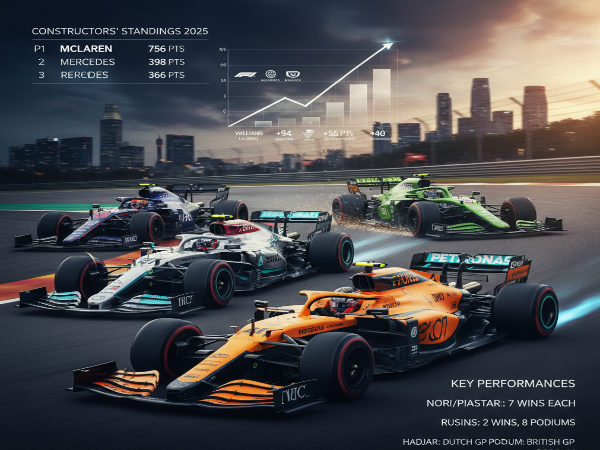Momentum and Margins: Which F1 Teams Are Outperforming Expectations?

The 2025 Formula 1 season has taken a sharp turn in recent weeks. A string of standout performances since the Japanese and Brazilian Grands Prix has reshaped both the constructors’ and drivers’ battles, highlighting unexpected strengths across the grid. Teams once viewed as long-shot midfielders are now consistently securing points and podiums at circuits where they previously struggled.
This uptick in form comes as title favourites attempt to stabilize their own campaigns. McLaren continues to dominate the standings, but the real intrigue has come from the pack behind them, where sudden surges from Mercedes, Williams, Racing Bulls, and Sauber have disrupted pre-season expectations.
Here’s a closer look at the squads that have surged past expectations and reshaped the 2025 competitive landscape.
McLaren’s 2025 Shockwave
McLaren were expected to be title favourites after their 2024 constructors’ crown, but not to blow the field away like this. After Brazil, they sit on 756 points, 358 clear of Mercedes in the constructors’ standings, and have already clinched the 2025 title. Norris and Piastri each have seven wins, and they’re first and second in the drivers’ standings on 390 and 366 points.
McLaren has won eleven of the first fourteen races, including long streaks of one-two finishes that F1 calls “leaving their rivals for dust”, something not seen since peak Mercedes. Pre-season pieces still framed Ferrari, Mercedes, and Red Bull as live threats rather than distant specks, so McLaren turning 2025 into one of the most dominant campaigns since 1990 is comfortably above the hype.
Racing Bulls Breaking Out
Racing Bulls were tipped to sit near the tail of the midfield again. F1 and Spanish media put them in the Haas / Aston group fighting for seventh, and some testing analysis had them behind Alpine in long-run pace. Instead, they are sixth on 82 points, ten clear of Aston Martin, and firmly in the midfield fight with Williams. The “sweet spot” narrative is backed up by pace and results.
Early in the year, Tsunoda qualified fifth in Australia and regularly dragged the car into Q3. Rookie Isack Hadjar has been the standout performer, scoring solid points, including sixth in Monaco and a breakthrough Dutch Grand Prix podium from P4 on the grid. The Formula 1 odds had them projected to hover around P8–P10, so sitting P6 in the table clearly counts as outperforming the brief.
Mercedes Rising Again
Most previews had Mercedes in “rebuild” mode: new rookie Andrea Kimi Antonelli alongside Russell, and questions about whether the W16 could fix the porpoising and balance issues that plagued earlier ground-effect cars. Mid-season, they were only third and 24 points behind Ferrari. After Brazil, Mercedes are now second in the constructors’, 32 points clear of Red Bull and well ahead of Ferrari.
George Russell is fourth in the drivers’ standings with 276 points, two wins (Canada and Singapore), and eight podiums in 2025. Articles and rankings consistently describe him as extracting “the most out of his Mercedes” and even “F1’s next best driver after Verstappen” on current form. Sitting clearly second and winning outright on circuits like Singapore is outperforming the conservative pre-season outlook.
Williams Breaking the Ceiling
Williams came into 2025 talking openly about sacrificing this season to focus on the 2026 rules, with James Vowles stressing a “long-term” project and warning that wind-tunnel and development effort would be diverted away from the FW47. They were tipped to scrap with Alpine and maybe Haas for “best of the rest” behind the big four, not to be a locked-in P5 team.
Instead, they sit fifth on 111 points, already miles ahead of their 2024 total of 17, and have produced their best start after nine races since 2016. Mid-season reports talk about Williams “continuing their upward trajectory” and being on course to hold P5 even while shifting development to 2026. That sort of points haul in what was officially branded a “transition” year is clear overperformance.
Sauber’s Unexpected Surge
If there is one team almost everyone wrote off, it was Sauber. Pre-season pieces talked about a “throwaway year” before the Audi works takeover and ranked them last due to “no signs of progress from the bottom of the order”. Early in the season, Reuters even framed a single fifth place in Spain as their best result in three years and noted that all their points then came from Nico Hülkenberg alone.
By mid-season, the story had flipped. Hülkenberg’s fifth in Spain lifted them off the bottom. His stunning podium from 19th on the grid at the British Grand Prix gave the 37-year-old his first-ever F1 podium and catapulted Sauber into the thick of the midfield. The Race then graded Sauber a B plus and explicitly described them as one of the pleasant surprises of 2025 relative to expectations.
Leading the Charge but Not Locked In
As the 2025 Formula 1 season heads into its final rounds, the teams surpassing expectations have become the central storyline reshaping the competitive landscape. McLaren’s dominance, Mercedes’ late-season surge, and the unexpected momentum from Williams, Racing Bulls, and Sauber have collectively disrupted the anticipated hierarchy.
Their recent form underscores how swiftly performance can swing when development gains align with opportunity. These shifts have pushed rivals to reassess their strategies and confront a grid that looks far different from pre-season projections. And with several decisive races still ahead, the picture remains fluid, leaving open the possibility of even more movement before the season draws to a close.



